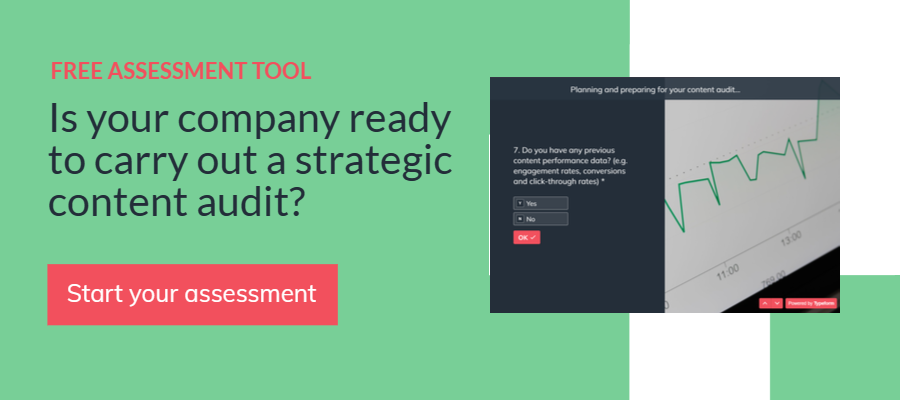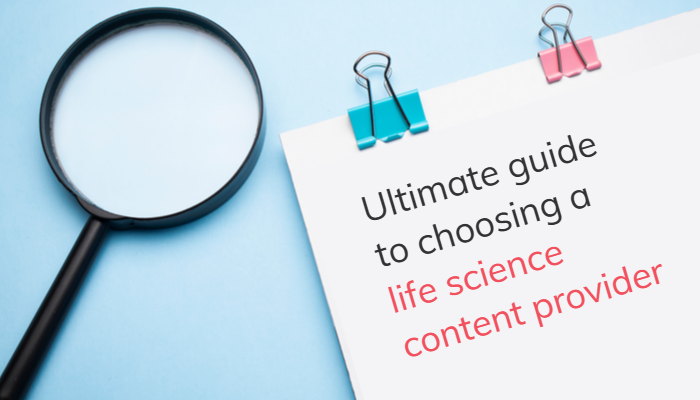As always, we've been keeping a close eye on the best ways to increase marketing ROI in the life science industry (while reducing costs). From monitoring trends and listening to our client's challenges, it's clear that repurposing content is still one of the best ways to get the most from your budget.
But how do you effectively repurpose content? There are many approaches to take, and it can sometimes feel overwhelming when looking to start your own content repurposing programme. To help, in this blog, we take a deeper dive into the topic of repurposing by describing 12 tried and tested approaches we’ve taken in the past to maximise the lifetime, impact, and results of the content marketing programmes that we manage for our life science clients.
Check out the list if you are looking for creative ways to get more from your content marketing investment.
Skip ahead:
- Edit longer webinars into short tutorials
- Record customer interviews for use in podcasts
- Combine several blog posts into an eBook or guide
- Convert eBooks and guides into blog posts
- Slice up your infographics
- Convert videos into podcasts (and vice versa)
- Secure guest posts on other relevant platforms
- Ungate old eBooks and whitepapers and convert them into website pillar pages
- Turn internal or customer data into infographics
- Convert blog posts and technical manuals into downloadable checklists
- Convert case studies into blog posts authored by your customers
- Rewrite your own blog posts from another perspective and get two-for-one
1. Edit longer webinars into short tutorials
Webinars are a great way to attract the interest of your users, deliver valuable information and build trust in your brand. However, they can also require a significant investment of time, energy and thought, so it’s important to extract every last piece of value from each one you run. One mechanism is to cut the webinar up into short tutorial, training or “snapshot” videos. This works especially well if your webinar explains how to use your product or service for different applications or outlines how to overcome different technical challenges.
Bonus tip: If your original webinar is educational in nature and offers lots of value to prospects, consider gating it behind a landing page and using the short snippets you develop as “promotional trailers” that drive people to access the full webinar. If you are struggling to create these short snippets, build them into your webinar production process by ensuring your speaker includes a short intro at the start and a short summary at the end of the webinar that you can cut out and re-use.
2. Record customer interviews for use in podcasts
Case studies, application stories and testimonials are a great marketing asset, many of which are developed by first interviewing a customer. Seeing as you have the customer on the phone, you could consider asking them if it is okay to record the interview and whether they would be happy for you to use a portion of the audio in your marketing (e.g. for podcasts). While it can be hard to secure this type of input, especially in the life science industry, your customers cannot agree to such requests if you don’t ask! Just make sure you flag your intentions BEFORE the customer joins the call, so they are not blindsided by your request when the call begins.
Bonus tip: Now, most life science professionals are much more comfortable taking part in video calls than ever before, so consider upgrading your phone interview to a video meeting – this could enable you to develop content for videos and podcasts, all at the same time.
3. Combine several blog posts into an eBook or guide
A classic example of content repurposing is to take a series of related blog posts and convert them into an eBook or guide. It’s important that the blog posts are on a similar theme and as closely related as possible, otherwise you may have to invest extra time editing the copy to ensure the final piece feels like a detailed, synergistic discussion of the topic (rather than a random jumble of disparate ideas). Regardless, it’s important to spend at least a little bit of time polishing the eBook to make it feel like a “single, unique piece” of content, by adding an introduction, outro/conclusion and ensuring each chapter (blog post) flows naturally into the next.
Bonus tip: Once you’ve created the eBook or guide, update all the original blog posts by adding a link to download the full eBook (including adding a call-to-action (CTA) button at the bottom of the blog post to drive people towards the eBook landing page). You can also use the eBook to fuel other activities, such as lead generation campaigns across paid media channels.
4. Convert eBooks and guides into blog posts
You can also apply the reverse logic from idea 1, by converting eBook and guide chapters into blog posts. In this case, extract sections of your eBooks that could work as stand-alone blog posts. Make sure you edit the start and end of your new blog posts, so that each works as an independent piece. If your eBook is over 4,000 words long, you can expect to generate anywhere from 2-6 blog posts using this method.
Bonus tip: Remember to add a link or CTA button to each new blog post, driving visitors to download the full eBook (by filling in your lead capture form).
5. Slice up your infographics
Life science infographics usually contain a number of distinct pieces of information, presented as graphs, graphics, schematics, flow charts, icons and more. In many cases, subsections of an infographic can be lifted from the main piece and shared as standalone graphics across social media, email etc., without the need for additional design or copywriting. This approach allows you to share an infographic with your audience multiple times without the risk of accidentally boring them or triggering information blindness. When sharing these “infographic slices”, be sure to provide a link back to view the full infographic on your website.
Bonus tip: If you plan and storyboard your infographics in a modular way, this will make it much easier to cut sections out for use on social media with minimal additional work.
6. Convert videos into podcasts (and vice versa)
It’s likely that many of your existing videos and webinars can be converted into podcasts by exporting the associated audio file. You might need to record some extra narration (such as an intro and outro), but this is still generally a lot easier than creating a podcast from scratch.
It’s also possible to repurpose your content in the other direction and turn your podcasts into videos. However, this tends to require more additional work, as the video portion must be created (whether that involves capturing new video footage, using stock video, or simply creating an image slide show).
Bonus tip: Plan and create a series of videos with the deliberate intention of exporting the audio as a podcast, as this will ensure the format, theme, structure, and story ideas you choose will be much more likely to work effectively across both mediums.
7. Secure guest posts on other relevant platforms
Submitting existing content as guest articles or blogs on another platform is a great way to expand your reach, build brand awareness and generate inbound links to your website (driving more website traffic and improving your search engine rankings). This could include pitching your story to a trade media publication, reaching out to bloggers in the life science sector or partnering with other relevant industry companies that serve the same audience as you (but that are not your competitors) to re-publish each other’s content as part of a co-marketing agreement.
Bonus tip: Make sure you include links back to your own website within your content, ideally to relevant blog posts, and technical resources etc. (rather than only to your homepage).
8. Ungate old eBooks and whitepapers and convert them into website pillar pages
Long-form pieces such as eBooks, whitepapers, and trends reports are a fantastic way to deliver lots of valuable insights and value to your prospects and customers (while also positioning your company as an industry thought leader and building trust in your brand). However, they also require a fair bit of investment to produce, so many companies gate these assets behind landing pages to drive lead generation.
While this is completely understandable (and something that we often recommend to clients), these assets are not usually indexed by search engines and can be a missed opportunity to boost SEO and drive more web traffic (especially as long-form, “pillar pages” are great for SEO). Therefore, consider converting these PDF assets into web pillar pages, either on your blog or as part of a dedicated resource section of your website.
Bonus tip: Converting eBooks and whitepapers into pillar pages doesn’t mean you need to stop using them to generate leads. You can still provide readers with the option to download a version for printing, sharing, archiving etc. (and request their email address to do so). Another approach is to create a PDF asset and gate it for a certain time period to generate leads (e.g. 6 months), before recycling the content as a pillar page after your first wave of intense content promotion is completed.
9. Turn internal or customer data into infographics
Scientists love data, and you’re probably sitting on a lot of it, either as part of internal studies or through collaborations with customers. For many life science companies, this data is housed within long-form, written pieces such as application notes, reports, manuscripts/papers, and case studies etc.
However, not everyone has the time needed to dive into the details. Therefore, one way to breathe new life into such pieces and attract a wider audience is to repurpose this data into infographics, delivering your key messages and findings in a succinct way that will grab attention and engagement (especially when using channels such as social media).
Bonus tip: This approach is not restricted to data generated from scientific experiments. For example, market research data can be repurposed into an infographic and used to demonstrate to your audience how well you understand their needs and challenges (and how you are best placed to support them).
10. Convert blog posts and technical manuals into downloadable checklists
Many life science companies use their blog to post content helping customers with technical challenges, tips and tricks. Often, this involves listing several factors that influence the success of an experiment or process, as well as describing the key steps a scientist should go through to troubleshoot the problem. Due to the nature of such posts, they are great for repurposing into downloadable checklists, which researchers can print and use at the lab bench (e.g. to ensure they have followed every step correctly or accounted for every possible source of error).
Bonus tip: Blog posts are not the only source of info that can fuel the development of checklists: most life science instrument and reagent companies routinely generate product manuals and technical specification documents to support their products. These contain a rich source of information that can help enable the rapid production of checklists, blogs, and a whole host of other content items.
11. Convert case studies into blog posts authored by your customers
Having guest authors write for your blog is a great way to keep the content interesting, diverse, and fresh while also boosting the credibility of your website as a source of interesting, unbiased information from across the industry. A quick way to achieve this is to repurpose existing customer case studies into guest blog posts that are “authored” by your customer, in their voice. However, be sure to seek permission from the customer before reposting the content on your site and expect them to request to review the content before publication.
Bonus tip: Featuring customers and other industry stakeholders on your blog can be a gateway to increase your reach – encourage the author to share the post with their network, perhaps by emailing them the link and asking them to share, or by mentioning them directly in social media posts promoting the content (e.g. on LinkedIn).
12. Rewrite your own blog posts from another perspective and get two-for-one
Your existing blog posts can provide inspiration for future posts, without the need to do as much work as creating a post from scratch. For example, rewriting an existing post from the opposite perspective can lead to useful insights that are valuable to your prospects. As a case in point, imagine you have a great post on “5 things you should do when capturing confocal images”. Flipping this around to create a post about the “5 things you should avoid when capturing confocal images” would be a useful exercise and, even if all 5 do’s and don’ts turn out to be mirror images, it will still help educate and deliver value to your audience by framing the information in a new way.
Bonus tip: Rewriting blog posts from another perspective is a powerful way to recycle content you have already published while still making it feel fresh. We recommend auditing all your old blog posts (e.g. over 12 months old) to see which delivered the most views/conversions. You can then use this analysis as the basis for selecting which posts to rewrite from an alternative viewpoint.
Could you be getting more value and better results from your life science content?
BioStrata's account and content teams are trained in a whole host of strategies designed to ensure our life science clients get every last drop of value from the content we create, helping us generate more awareness, leads and sales opportunities for the lowest possible investment. Whether you require expert assistance in performing a strategic content audit or developing a content strategy aligned with your business goals, BioStrata can assist you. Explore our science writing and content creation services to learn more.
Performing a strategic content audit can help life science marketers maintain and produce content that is relevant and effective. This involves setting specific objectives, evaluating all content assets, analysing performance, creating an action plan, and implementing changes to continuously enhance your content and achieve success within your organisation.
If your life science company is looking to conduct a strategic content audit, we have developed a 10-step assessment tool to help you determine if your organisation is ready. By completing the series of questions, you can opt to receive a valuable recommendations report with suggestions on what steps you need to take prior to performing your own audit.




